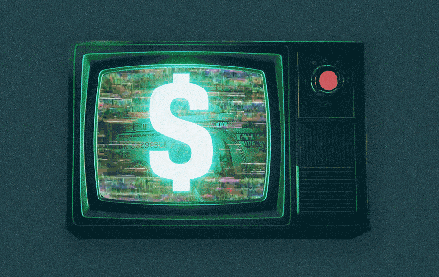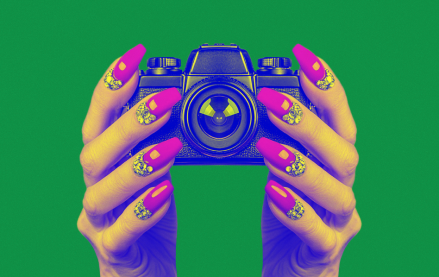Future of TV Briefing: A Super Bowl streaming post-mortem with Tubi’s Nicole Parlapiano

This Future of TV Briefing covers the latest in streaming and TV for Digiday+ members and is distributed over email every Wednesday at 10 a.m. ET. More from the series →
This week’s Future of TV Briefing features an interview with Tubi CMO Nicole Parlapiano about the Fox-owned free, ad-supported streamer’s Super Bowl broadcast.
- Tubi’s big game
- YouTube’s TV inflection point, Netflix’s video podcast plans and more
Tubi’s big game
My sister hadn’t heard of Tubi before Sunday. But if it weren’t for the Fox-owned free, ad-supported streaming service, neither she nor I would have been able to tune into this year’s Super Bowl. And we weren’t the only ones to stream Sunday’s big game.
13.6 million people streamed the Super Bowl on Tubi, according to numbers that Fox announced on Monday.
Considering how many people streamed the Super Bowl on Tubi — and as someone in that cohort — what may be most notable about Tubi’s Super Bowl was how solid it seemed to be. My sister and I streamed the game over a cellular connection on my phone in a location where our dad didn’t have any service (shoutout to my carrier, Verizon, I guess), and the stream loaded immediately each time without any noticeable buffering or resolution loss.
To be clear, Tubi’s Super Bowl stream wasn’t entirely in sync with the traditional TV broadcast. There was, on average, a 26-second delay between the TV broadcast and Tubi’s stream, according to data from real-time content delivery provider Phenix. But that’s a lower latency than streaming pay-TV services, such as Hulu + Live TV (62 seconds), Sling (64 seconds), YouTube TV (67 seconds) and Fubo (78 seconds).
Maybe I shouldn’t have been surprised by Tubi’s Super Bowl stream. While ostensibly the biggest live-streaming test yet for a service most associated with on-demand programming, Tubi does stream NBA G League games and is owned by Fox, which streamed the Super Bowl on its Fox Sports app in 2023.
Which raises the question: Now that Tubi has streamed the Super Bowl, what other plans does it have for live programming on the service? It’s a question I put to Tubi CMO Nicole Parlapiano in the interview below, which was recorded on Tuesday afternoon.
This interview has been edited for length and clarity.
The early numbers show 13.6 million viewers for Tubi. How does that compare to expectations going in?
It’s around what we expected. It’s complicated because we think about overall streaming devices, and then we work with Nielsen to get average viewing minutes, which is how you get that [early viewership figure]. At points in the game, we had more concurrent viewership, but it really depends on how long folks are watching. So it’s on par.
But initially when we forecasted, we were planning to market this much earlier than we were actually able to. So we had about three weeks to make people aware that Tubi was an option. Our initial model had assumed that we had probably six to eight weeks to do that.
The conversations on social were largely positive. Ninety-three percent of folks were pleasantly surprised, grateful that Tubi could come through for whatever their situation was that day, and we were also the most talked-about brand on social that night, according to Sprout Social.
You’ve described the Tubi audience as skewing female and younger. What was the predominant audience profile for viewers who streamed the Super Bowl on Tubi compared to the average Tubi viewer?
I don’t have any demographic data yet. We have a large monthly active viewership, 97 million [monthly active users]. So we definitely had folks that have always been on Tubi. And then interestingly enough, we were marketing to younger and cordless viewers that did not have cable or any [pay-TV] access. So we were really targeted in our approach to make sure that we were really targeting those folks that would have no other way [to watch the Super Bowl].
Did a majority of people watch on connected TVs?
We can follow up with that, but I can tell you that the preliminary numbers I’ve seen, that’s where the bulk of it came from.
Which I imagine was what you would have expected going in?
It was. That’s also our dominant platform. We have really great mobile viewership as well, but [CTV’s] kind of our base business.
Tubi historically has positioned itself as predominantly on-demand programming. This was obviously a major live programming event. What did you all have to do in order to get people aware that not only could they watch the Super Bowl confidently but that they could confidently watch the Super Bowl on a service known for on-demand programming, not live? Especially coming off of Netflix having glitches with live programming?
That was the crux of our marketing brief: No one’s going to believe we have the chops to stream the game well, considering where we are in people’s maps versus Netflix.
We brought in a lot of the IP from Fox Sports in our promotional assets. You saw Erin Andrews, you saw [Rob Gronkowski]. It was very much marketed as Fox Sports’s takeover on Tubi. And then earlier in the day, we had the entire Fox pre-game show running [at] 11:30 a.m. ET because we wanted to bring people in and validate that we had the goods early in the day.
And then on the technical side, we work at a parent company that is live-streaming sports all the time and shipping it to the NFL or local stations. It’s different than Netflix that is built on pure-play streaming. People don’t really connect us with Fox, but we worked with the Fox tech team to basically do what they normally would do on Super Bowl, just brought over to the Tubi infrastructure.
Did any extra testing need to be done given that this was the first time the Super Bowl was available on a free streaming service and so the potential for there to be an order of magnitude more people streaming it than even the Fox Sports technology may have experienced in the past?
We did some dress rehearsals along the way with some college sports games, some golf. Nothing at this scale.
Are you planning to do more promotion around the live programming on the service?
Yeah. I mean, it depends on the market. Right now we do have Liga MX in Mexico. We have the whole season; we have a lot of games. So I think there’s more testing we can do now that we have this muscle of how we can lean into that more and really grow viewership on that side through live sports and experimentation that could probably be pulled into other markets.
So Tubi has now streamed the Super Bowl and also airs Liga MX, NBA G League games. What plans are there to stream more live events on the service?
Nothing in the works right now. Just taking a beat, learning from this, deciding if there’s anything else opportunistic we want to do. Now we have the confidence that we can honestly do anything after streaming the biggest media event in the U.S.
I guess that’s like asking Jalen Hurts what workout he’s doing next.
Yeah, we just will now go into any of those opportunities with eyes a little bit more wide open and knowing what the lift is.
This article has been updated to reflect that Fox, not Nielsen, was the source of Tubi’s Super Bowl viewership figure.
What we’ve heard
“The way we do video [Spotify doesn’t] yet support. Right now on Spotify, you can replace your audio podcast with a video podcast, but you can’t take the audio podcast and leave it there and then add more content. I would love to add our videos … but I don’t want to take away the podcast. That is a technical limit that they have.”
— Bloomberg Radio’s Colin Tipton on Spotify’s video podcast upload workflow
Numbers to know
127.7 million: Number of people who watched the Super Bowl across traditional TV, streaming and digital.
43%: Percentage share of streaming subscribers who subscribed to an ad-supported tier in the second half of 2024.
125 million: Number of streaming subscribers that Disney had at the end of its latest quarter.
What we’ve covered
Is the early ad rollout to blame for a lackluster Super Bowl?:
- Because of the early rollouts, some marketers and agency execs think this year’s Super Bowl ads are less likely to be remembered long term.
- Some brands teased their campaigns a month before the big game.
Read more about Super Bowl ads here.
How U.K.-based creators took advantage of the U.S. TikTok outage:
- Creators in the U.K. posted 15% more videos on TikTok in the week after the outage compared to the week prior.
- The creators may have been looking to seize an opening if U.S. creators turned their attentions to other platforms.
Read more about U.K.-based TikTok creators here.
How podcasters are measuring videos’ role in growing incremental audiences:
- Publishers including Bloomberg, The New York Times and Vox Media are using video podcasts to attract audiences who aren’t already tuning into shows’ audio feeds.
- Gauging to what extent video podcast audiences are incremental to audio audiences is difficult to do.
Read more about video podcasts here.
Netflix readies pan-European rollout of its in-house ad tech amid pricing competition:
- Netflix will make its European ad inventory available through Google’s and The Trade Desk’s demand-side platforms later this month.
- Ad buyers continue to look for Netflix to lower its ad prices.
Read more about Netflix here.
How brands are growing episodic creator partnerships to reach a younger audience:
- Match Group, Amazon and Walmart are among the brands sponsoring creators’ longer-term series.
- Match Group hired six creators to produce a six-post series last fall.
Read more about brands’ creator deals here.
What we’re reading
YouTube’s TV inflection point:
People in the U.S. now spend more time watching YouTube on TV screens than on their phones, according to Deadline.
Netflix’s video podcast plans:
As the streamer expands the content it loads up on, Netflix is considering doing deals to put video podcasts on its service, according to Business Insider.
The “Drive to Survive” distributor is weighing whether to bid for rights to stream Formula 1 races in the U.S. starting next year, according to The Times.
The company behind ChatGPT and text-to-video tool Sora has been working to secure deals with major film-and-TV studios but has yet to succeed in doing so, with the studios reticent to sign a deal with the AI tech provider, according to Bloomberg.
Not exactly news to folks reading this, but it’s getting harder to get like-for-like measurements of audiences across traditional TV and streaming, according to The New York Times.
Want to discuss this with our editors and members? Join here, or log in if you're already a member.
More in Future of TV

Future of TV Briefing: How agencies are setting up their programmatic teams for the agentic AI era
This week’s Future of TV Briefing recaps two sessions from last week’s Digiday Programmatic Marketing Summit about how agencies’ programmatic buying teams are evolving.

Future of TV Briefing: The streaming ad upfront trends, programmatic priorities revealed in Q3 2025 earnings reports
This week’s Future of TV Briefing looks at what TV and streaming companies’ latest quarterly earnings report indicate about the state of the streaming ad market.

Future of TV Briefing: The creator economy needs a new currency for brand deals
This week’s Future of TV Briefing looks at why paying creators based on reach misses the mark and what IAB is doing to clear up the creator-brand currency situation.








